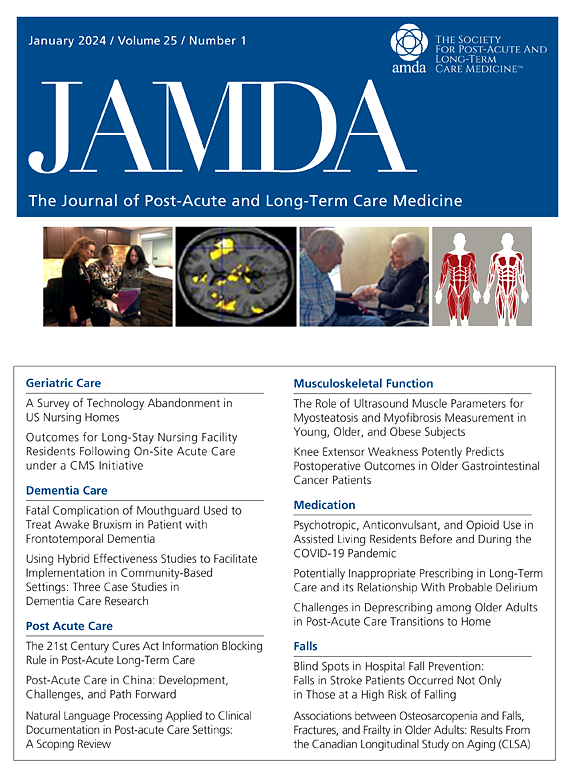短物理性能电池或椅子支架:哪个更能预测高功能老年人的残疾?
IF 4.2
2区 医学
Q2 GERIATRICS & GERONTOLOGY
Journal of the American Medical Directors Association
Pub Date : 2025-07-15
DOI:10.1016/j.jamda.2025.105720
引用次数: 0
摘要
目的:比较短体能测试(SPPB)和椅架测试(CST)在识别日常生活工具活动(IADL)和基本日常生活活动(BADL)中意外残疾风险方面的能力,对高功能老年人进行8年随访。设计:纵向研究。环境和参与者:来自英国老龄化纵向研究(ELSA)的2386名参与者,他们没有IADL/BADL残疾,基线时步态速度大于0.8 m/s。方法:采用受试者工作特征曲线评价SPPB和CST的准确性,识别发生IADL/BADL残疾的风险。随后,根据SPPB和CST截断点,使用广义线性混合模型对社会人口统计学、行为和临床特征进行调整,分析发生IADL/BADL残疾的轨迹。结果:SPPB≤11分和CST≥11.5秒比SPPB≤10分和CST >15秒更准确地识别出发生IADL/BADL残疾的风险,SPPB≤10分和CST >15秒是目前文献中最常推荐的分界点。SPPB≤11分、CST≥11.5秒时,发生IADL/BADL残疾的轨迹相似。结论和意义:SPPB≤11分和CST≥11.5秒比先前推荐的分界点更准确地识别出发生IADL/BADL残疾的风险。由于两种仪器在预测意外致残的轨迹方面相似,CST可能是临床筛查中更实用的选择,因为它简单且给药时间更短。本文章由计算机程序翻译,如有差异,请以英文原文为准。
Short Physical Performance Battery or Chair Stand: Which Better Predicts Disability Among High-Functioning Older Adults?
Objective
To compare the Short Physical Performance Battery (SPPB) and Chair Stand Test (CST) in terms of their ability to identify the risk of incident disability in instrumental activities of daily living (IADL) and basic activities of daily living (BADL) over an 8-year follow-up among high-functioning older adults.
Design
Longitudinal study.
Setting and Participants
A sample of 2386 participants from the English Longitudinal Study of Ageing (ELSA) who were free of IADL/BADL disability and had a gait speed greater than 0.8 m/s at baseline.
Methods
Receiver operating characteristic curves were used to evaluate the accuracy of the SPPB and CST to identify the risk of incident IADL/BADL disability. Subsequently, the trajectories of incident IADL/BADL disability were analyzed according to the SPPB and CST cutoff points using generalized linear mixed models adjusted for sociodemographic, behavioral, and clinical characteristics.
Results
Performance in the SPPB ≤11 points and CST ≥11.5 seconds more accurately identified the risk of incident IADL/BADL disability than SPPB ≤10 points and CST >15 seconds, which are the cutoff points most commonly recommended in the literature to date. Finally, the trajectories of incident IADL/BADL disability were similar for SPPB ≤11 points and CST ≥11.5 seconds.
Conclusions and Implications
SPPB ≤11 points and CST ≥11.5 seconds more accurately identified the risk of incident IADL/BADL disability than previously recommended cutoff points. As both instruments were similar in predicting trajectories of incident disability, the CST may represent a more practical choice for clinical screening, given its simplicity and shorter administration time.
求助全文
通过发布文献求助,成功后即可免费获取论文全文。
去求助
来源期刊
CiteScore
11.10
自引率
6.60%
发文量
472
审稿时长
44 days
期刊介绍:
JAMDA, the official journal of AMDA - The Society for Post-Acute and Long-Term Care Medicine, is a leading peer-reviewed publication that offers practical information and research geared towards healthcare professionals in the post-acute and long-term care fields. It is also a valuable resource for policy-makers, organizational leaders, educators, and advocates.
The journal provides essential information for various healthcare professionals such as medical directors, attending physicians, nurses, consultant pharmacists, geriatric psychiatrists, nurse practitioners, physician assistants, physical and occupational therapists, social workers, and others involved in providing, overseeing, and promoting quality

 求助内容:
求助内容: 应助结果提醒方式:
应助结果提醒方式:


